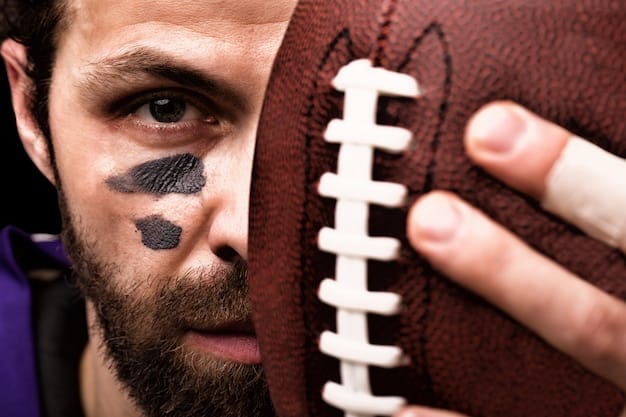New NFL Concussion Protocol Changes 2025: Player Safety & Game Strategy Impact

The NFL’s new concussion protocols in 2025 are set to significantly enhance player safety through stricter diagnostic criteria and immediate removal from play, directly influencing game strategy by potentially altering roster depth, coaching approaches, and player development.
The landscape of professional football is constantly evolving, with player well-being increasingly taking center stage. One of the most significant shifts on the horizon pertains to advancements in player safety, particularly concerning head injuries. Understanding how will the new NFL concussion protocol changes in 2025 impact player safety and game strategy is crucial for both fans and stakeholders, as these adjustments promise to reshape the sport from its foundational elements to its strategic intricacies.
evolving standards: the new NFL concussion protocol
The National Football League has been under intense scrutiny regarding player safety, especially concerning concussions and their long-term neurological effects. As research deepens and medical understanding advances, the league continuously refines its protocols. The impending changes in 2025 represent a significant stride forward, building upon years of incremental adjustments and lessons learned from past experiences. These aren’t just minor tweaks; they reflect a comprehensive re-evaluation of how concussions are identified, managed, and prevented during high-stakes competition.
The motivation behind these changes is multi-faceted, driven by a combination of scientific discovery, player advocacy, and public pressure. The goal is to create a safer environment for athletes while preserving the integrity and excitement of the game. This balance is delicate, requiring thoughtful implementation and continuous assessment.
stricter diagnostic criteria
A core component of the 2025 protocol update involves a more stringent approach to concussion diagnosis. The emphasis is on early detection and a lower threshold for removing a player from competition, even if symptoms seem subtle or transient initially.
- Expanded Spotter Role: Independent certified athletic trainers (UNCERTs) and booth ATC spotters will have enhanced authority and clearer guidelines for identifying potential concussions. Their ability to stop play and initiate evaluations will be amplified.
- Neurological Baselines: Players will undergo more comprehensive pre-season neurological baseline testing, providing more precise individualized benchmarks for comparison if a suspected concussion occurs. This helps differentiate pre-existing conditions from acute injury.
- Advanced Sideline Technology: The integration of cutting-edge technology, such as eye-tracking devices and improved video analysis, will assist medical personnel in making rapid, objective assessments on the sideline. This aims to reduce reliance on subjective player reporting.
Moreover, the updated protocols will likely include more specific triggers for mandatory removal. For example, any observed motor instability, vacant stare, or potential loss of consciousness, however brief, will necessitate immediate removal for a full evaluation in a quiet area away from the sideline. This stringent approach ensures that no potential head injury goes unexamined, prioritizing player health above immediate game outcomes.
enhanced return-to-play process
Beyond the initial diagnosis, the new protocols will likely mandate a more cautious and individualized return-to-play process. This iterative approach ensures that players are fully recovered before re-entering competitive play, minimizing the risk of re-injury or exacerbating existing conditions.
The current five-step return-to-play protocol, which involves rest, light aerobic exercise, strength training, football-specific drills, and full-contact practice, will likely be reinforced with more explicit criteria for advancing through each stage. Emphasis will be placed on cognitive recovery and the absence of any post-concussion symptoms. Specialists, including independent neurologists, will play an even more critical role in the clearance process, providing objective assessments. This meticulous approach underscores the league’s commitment to long-term player health, moving beyond a simple “absence of symptoms” checklist to a more holistic recovery model, ensuring players are not only physically ready but also cognitively robust enough to withstand the rigors of football.
impact on player safety: mitigating long-term risks
The overarching goal of the 2025 concussion protocol changes is a tangible improvement in player safety. This isn’t just about preventing immediate injury; it’s fundamentally about mitigating the long-term, devastating effects associated with repetitive head trauma, such as Chronic Traumatic Encephalopathy (CTE). By implementing stricter rules and leveraging advanced science, the NFL aims to safeguard its athletes’ neurological health, potentially extending their quality of life long after their playing careers conclude. The emphasis on immediate removal from play, even for subtle signs, significantly reduces the likelihood of players suffering second-impact syndrome, a rare but often fatal condition that can occur when a second concussion is sustained before the brain has fully recovered from an initial one. This proactive approach prioritizes definitive diagnosis and rehabilitation over quick re-entry into the game.
The changes also foster a cultural shift within the league. Players are often driven by an immense competitive spirit, sometimes leading them to downplay symptoms to stay on the field. The new protocols aim to remove this burden from the players, empowering medical staff to make autonomous decisions for their safety. This cultivates an environment where reporting symptoms is encouraged, not penalized, and where player health is undeniably the top priority, setting a new standard for athlete care in professional sports. The hope is that these proactive measures will lead to a significant reduction in the cumulative impact of head injuries over a player’s career, thereby reducing the prevalence and severity of conditions like CTE.

strategic implications for teams and coaches
The new concussion protocols, while vital for player safety, will undoubtedly send ripple effects throughout team operations and game strategy. Coaches, general managers, and trainers will need to adapt their approaches significantly, considering both immediate tactical adjustments and long-term roster management. The increased likelihood of players being sidelined due to concussion protocols means that depth at every position becomes even more critical. Teams can no longer afford to have a handful of star players without reliable backups, as the immediate removal rule can unpredictably alter game plans. This will necessitate a shift in how teams scout, draft, and develop talent, prioritizing versatility and robust training for a wider pool of players. The margin for error in roster construction will shrink, placing a premium on comprehensive team building that accounts for potential in-game absences. Coaches will need to recalibrate their practice methods, potentially reducing high-impact drills to minimize concussion risk during the week, without sacrificing preparation intensity relevant to game situations.
roster management and depth charts
The most immediate and apparent impact will be on roster composition. Teams will likely need to carry more players capable of stepping in at crucial positions. Take, for instance, quarterbacks or cornerbacks – positions where a single concussion could sideline a starter for multiple weeks. This demands a higher standard for backup players, not just in terms of skill but also in their preparedness to execute complex game plans on short notice.
- Increased focus on versatile players: Athletes who can play multiple positions will become even more valuable, offering coaches flexibility in managing unexpected absences.
- Elevated importance of practice squad: The practice squad may transition from a developmental ground to a critical reserve pool, with players needing to be game-ready at all times.
- Strategic investment in backup talent: Draft capital and free agency spending might see a shift, with more emphasis placed on acquiring high-quality backups rather than just focusing on starters.
Furthermore, managing the salary cap under these conditions becomes more complex. Teams will need to allocate resources to secure reliable depth without compromising their ability to retain star players, requiring refined financial strategies. This also highlights the importance of robust player development programs, ensuring a consistent pipeline of talent ready to step up when needed.
game planning and in-game adjustments
Coaches face the formidable task of adapting their game plans. The possibility of losing a key player to a concussion assessment at any moment mid-game introduces a new layer of uncertainty. This could lead to more conservative play-calling in certain situations, or a greater reliance on plays that distribute responsibilities across multiple players rather than concentrating them on one or two high-risk individuals.
In-game adjustments will become even more pivotal. Coaches will need to have contingency plans for various scenarios, including the sudden loss of a quarterback, offensive lineman, or defensive leader. This requires extensive preparation, simulating various player absence scenarios during practice and ensuring that every player understands their role, even if it changes on the fly. The integration of real-time communication between sideline medical staff and coaching staff will be critical, allowing for immediate strategic shifts based on player health updates. This might also lead to creative substitutions or schemes that minimize contact for players who have a history of concussion or are deemed at higher risk, subtly altering the tactical landscape of a match. The coaching ethos will likely lean more towards adaptability and rapid response, ensuring that the team remains competitive even when unforeseen circumstances arise on the field.
coaching and player development adaptations
The ripple effect of the new concussion protocols extends deep into the foundations of football: how players are taught and developed. Coaches, from youth leagues to the professional level, will need to adapt their methodologies to prioritize safer techniques and instill a heightened awareness of head safety from an early age. This evolution in coaching is not merely about compliance; it’s about fundamentally rethinking how the game is played to minimize risk while retaining its athleticism and competitive intensity. The emphasis will shift towards heads-up tackling, proper blocking techniques that avoid leading with the crown of the helmet, and continuous education on concussion symptom recognition. This will eventually lead to a generation of players with ingrained habits and a greater understanding of the importance of self-reporting symptoms, fostering a culture of safety that permeates all levels of the sport.
Furthermore, player development programs typically focus on physical conditioning, skill acquisition, and strategic understanding. With the new protocols, they will necessarily incorporate more rigorous training on concussion awareness, emphasizing the importance of reporting symptoms immediately and adhering to recovery protocols. This holistic development approach ensures that players are not only physically robust but also intellectually informed about the risks associated with their sport, empowering them to make health-conscious decisions throughout their careers. The change is profound, moving beyond superficial rule changes to ingrained behavioral shifts within the sport’s culture, aiming for a future where elite athleticism coexists harmoniously with paramount player well-being.
refining tackling and blocking techniques
The most direct impact on player development will be the continued emphasis on safer techniques. The practice of “head up” tackling, where players keep their eyes up and use their shoulders to initiate contact, will become even more universally drilled from youth football through the NFL. Similarly, offensive and defensive linemen will be coached on blocking techniques that aim to drive through opponents without leading with the helmet.
These techniques are not new, but the renewed urgency from the 2025 protocols will undoubtedly elevate their importance in practice drills and coaching evaluations. Coaches who fail to instill these safer methods might find their players more susceptible to protocol-mandated removals, directly impacting team performance and player availability. There will be a greater integration of non-contact drills designed to reinforce proper form and spatial awareness, reducing the overall number of high-impact repetitions in practice, thus preserving players for game day and reducing weekly concussion exposure. The NFL will likely invest more in educational programs for coaches at all levels, sharing best practices for teaching these safer methods effectively.
integrating concussion education
Player education will also undergo a significant transformation. Beyond physical drills, players will receive more extensive and frequent training on concussion recognition, recovery, and the long-term implications of head injuries. This education will be crucial for empowering players to advocate for their own health.
- Symptom recognition training: Players will be taught to identify subtle signs of concussion in themselves and teammates, fostering a culture of mutual care and vigilance.
- Emphasis on self-reporting: Creating an environment where players feel safe reporting symptoms without fear of judgment or loss of playing time.
- Long-term health awareness: Educating players about the potential long-term effects of concussions, including the importance of adhering to recovery protocols.
This comprehensive educational approach aims to shift the mindset from “playing through” injuries to proactively protecting one’s brain health. It’s about empowering players to be active participants in their safety, fostering a more responsible and health-conscious generation of athletes. This will include workshops, mandatory modules, and access to medical professionals who can provide in-depth information about neurological health, moving beyond merely signing a waiver to fostering genuine understanding and buy-in from the athletes themselves.
balancing player safety with game competitiveness
The NFL operates in a complex ecosystem where player safety must be balanced with the inherent competitiveness and excitement of professional sports. Striking this balance is incredibly challenging, yet essential for the long-term sustainability and appeal of the league. The new concussion protocols, by their nature, will influence this equilibrium. While the primary goal is undeniable — to protect athletes — the changes also introduce variables that could alter the flow and intensity of games. The potential for more frequent stoppage, player removals, or even changes in play style designed to minimize contact could subtly shift the dynamic viewers have come to expect. This is not necessarily a negative outcome, as an overtly brutal sport might lose its appeal over time, but it signifies a deliberate evolution. The league must effectively communicate these changes and their benefits to maintain fan engagement, showing that a safer game can still be a thrilling one. The challenge lies in minimizing the disruption to competitive balance while maximizing the safety benefits, ensuring the game remains both captivating and responsible.
Moreover, the perception of fairness and consistency in implementing these protocols across all teams will be paramount. Any perceived discrepancies in how concussions are diagnosed or how players are cleared could lead to controversy and undermine public trust. The league, therefore, must ensure uniform training and unbiased application of the rules. This dedication to transparent and equitable enforcement will be just as crucial as the protocols themselves in maintaining the league’s reputation and the integrity of the sport. The league’s success in this delicate balancing act will determine if the new protocols become a model for other contact sports or face significant pushback from players and fans, creating friction between the desire for unbridled competition and the increasing demand for athlete welfare.
future outlook and continuous refinement
The 2025 NFL concussion protocol changes are not an endpoint but rather another significant step in an ongoing journey. Sports science, particularly in the realm of brain trauma, is an incredibly dynamic field, with new research and technological advancements emerging regularly. Therefore, the NFL’s approach to concussion management must remain adaptive and open to continuous refinement. The league has a responsibility to not only implement these new protocols but also to learn from their application, gather data, and be prepared to make further adjustments as understanding evolves. This iterative process is crucial for staying at the forefront of player safety and ensuring that the protocols remain effective and relevant in the face of new scientific discoveries.
The future of concussion management in the NFL will undoubtedly involve further integration of predictive analytics, artificial intelligence, and personalized medicine. Imagine a scenario where a player’s genetic markers, brain imaging data, and personal injury history could be combined to create a highly individualized risk profile, guiding their participation and return-to-play decisions. The advancements in wearable technology could offer real-time data on impacts and brain activity, providing even more objective diagnostic tools. Such innovations, currently in their nascent stages, hold immense promise for revolutionizing player safety beyond the scope of the 2025 protocols, taking us into a new era where technology and medical science converge to create the safest possible environment for elite athletes.
technological advancements and data analytics
The integration of technology will continue to be a cornerstone of concussion protocol development. Beyond current methods, future innovations could include:
- Advanced Helmet Sensors: Next-generation sensors that provide even more granular data on the force, location, and type of impacts, helping to identify subconcussive hits and areas of high risk.
- Biomarkers: Ongoing research into blood biomarkers (e.g., tau protein) that could provide objective, rapid, and accurate diagnostic tools for concussion on the sidelines or even in locker rooms.
- AI-Powered Diagnostics: Artificial intelligence and machine learning models that can analyze vast amounts of data—from video footage to sensor readings and player health records—to predict risk or assist in diagnosis.
These technological leaps promise to make concussion assessment less reliant on subjective reporting and more on objective, data-driven insights. The NFL would serve as a powerful real-world laboratory for these innovations, driving forward advancements that could benefit contact sports globally, transforming the very definition of sideline medicine. This commitment to leveraging technology for safety underscores a progressive vision for the league, positioning it as a leader in sports medicine innovation.
long-term research and collaboration
The NFL’s commitment to concussion safety extends beyond its internal protocols to significant investments in long-term research. Collaborations with leading medical institutions, independent researchers, and player associations will be crucial for understanding the full spectrum of neurological impacts and developing more effective prevention and treatment strategies.
This includes funding studies on neurodegenerative diseases like CTE, exploring novel therapies for post-concussion syndrome, and investigating the most protective training methods. This collaborative, research-driven approach is essential for continuously improving player well-being, pushing the boundaries of sports medicine, and ensuring that future protocol adjustments are based on the soundest scientific evidence available. The continuous funding and transparent sharing of research findings will be vital for maintaining trust and driving progress in this critical area, ensuring that every decision made about player health is rooted in the most current and robust scientific understanding, creating a legacy of responsibility beyond the current generation of players.
| Key Point | Brief Description |
|---|---|
| 🧠 Stricter Diagnosis | Enhanced spotter roles and advanced tech for quicker, more objective concussion identification. |
| 🚑 Improved Return-to-Play | More cautious, individualized recovery phases before players can re-enter gameplay. |
| 📋 Roster & Strategy Shifts | Teams need deeper rosters and adaptable game plans due to potential player absences. |
| 🛠️ Coaching Adaptations | Increased focus on safer tackling techniques and comprehensive concussion education for players. |

frequently asked questions
▼
The primary goals are to enhance player safety by implementing stricter diagnostic criteria for concussions, ensuring immediate removal from play for evaluation, and enforcing more cautious return-to-play guidelines. These changes aim to mitigate long-term neurological risks, such as CTE, and foster a culture where player health is prioritized above all else. They also seek to instill greater trust in the league’s commitment to athlete welfare.
▼
The changes will significantly impact game strategy by requiring deeper team rosters and greater roster flexibility. Coaches will need to prepare more extensive contingency plans for player absences, and in-game adjustments will become even more critical. There might also be a subtle shift towards coaching tactics that inherently minimize high-impact collisions, influencing play-calling and overall team approach during games.
▼
While the explicit intent is not to eliminate physicality, the emphasis on safer techniques and immediate removal might indirectly lead to a less aggressively impact-focused style of play. The goal is to make the game safer, not necessarily less physical. Players and coaches will adapt by focusing on skill and strategy within the rules, rather than relying on dangerous contact, ensuring the game remains thrilling while prioritizing athlete well-being.
▼
Technology will play an increasingly vital role. This includes advanced sideline diagnostic tools like eye-tracking devices and improved video analysis for real-time assessment. Future advancements may also incorporate more sophisticated helmet sensors, blood biomarkers for objective diagnosis, and AI-powered analytics to predict risk and personalize recovery plans, moving towards a more data-driven approach to player safety management.
▼
Player education will be a key component, with comprehensive training on concussion symptom recognition for themselves and teammates. There will be a strong emphasis on fostering a culture of self-reporting without fear of repercussions. Educational programs will address the long-term health implications of head injuries, ensuring players are empowered with knowledge to make informed decisions about their own well-being and health advocacy throughout their careers.
a safer future for the sport
The impending NFL concussion protocol changes in 2025 signify a profound evolution in how professional football addresses player safety. These adjustments are more than mere regulatory updates; they represent a fundamental commitment to safeguarding the long-term health of athletes, reshaping the game from the ground up. By fostering a safer environment through stricter diagnostic criteria, enhanced return-to-play processes, and a cultural shift towards prioritizing well-being, the league is aiming to mitigate the devastating impacts of head trauma. While these changes will undoubtedly introduce new strategic dimensions for teams and coaches, demanding greater roster depth, adaptability, and a refined approach to player development and coaching, they are ultimately a necessary step towards a more sustainable and responsible future for the sport. The ongoing commitment to scientific research and technological integration promises that the journey towards optimal player safety is far from over, ensuring that the NFL continues to lead the way in athlete welfare while maintaining the exhilarating spirit of the game viewers have come to appreciate. This comprehensive overhaul reflects a maturing understanding of sports’ impact on the human body, setting a new benchmark for professional leagues worldwide and securing the game’s viability for generations to come, balancing aggressive competition with compassionate care.





